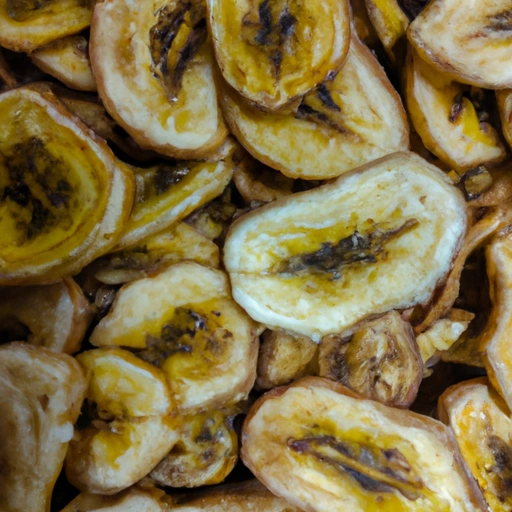Dried Banana
Description

Dried banana is a dehydrated form of the fresh banana fruit. They are often sliced before drying, which can be done through various methods including sun-drying, oven-drying, or using commercial dehydrators. The drying process concentrates the natural sugars found in bananas, giving them an intensified sweet flavor and chewy texture. Dried bananas are a convenient, non-perishable, and portable snack that can be enjoyed as is or used as an ingredient in a variety of culinary preparations.
Common uses
Dried bananas are commonly used as a snack, in breakfast cereals, trail mixes, and as a topping for yogurt or oatmeal. They can also be found in baked goods such as muffins, cookies, and cakes, and are sometimes ground into flour for use in gluten-free recipes.
Nutritional value
Calories
A 1-ounce (28 grams or roughly 2 tablespoons) serving of dried bananas contains approximately 100 calories.
Protein
This serving size also provides about 1 gram of protein, making it a minor source of this macronutrient.
Fat
Dried bananas are generally low in fat, with less than 0.5 grams per serving.
Carbohydrates
The majority of the calories in dried bananas come from carbohydrates, with a serving containing about 25 grams, mostly in the form of sugars. Dietary fiber is present too, at around 2 to 3 grams per serving.
Vitamins
While some vitamins may be lost during the drying process, dried bananas still contain a good amount of vitamin A, and some B vitamins, particularly vitamin B6.
Minerals
Dried bananas are also a source of important minerals, including magnesium, potassium, and a small amount of calcium and iron.
Health benefits
Dried bananas provide a quick source of energy due to their natural sugars and carbohydrates. They are also a good source of dietary fiber which can aid in digestion. The presence of potassium helps maintain proper muscle function and regulates blood pressure. The vitamin B6 in dried bananas supports brain health and the immune system.
Potential risks
As with any dried fruit, dried bananas are more calorie-dense than their fresh counterparts, so they should be consumed in moderation, especially by individuals monitoring their calorie intake. Additionally, some commercially available dried bananas may contain added sugars or preservatives which could detract from their nutritional value.
Common recipes
Dried bananas are an ingredient in many recipes such as banana bread, muffins, pancakes, and granola. They can also be rehydrated and blended into smoothies or mixed into batter for a natural sweet flavor.
Cooking methods
Dried bananas can be eaten raw, soaked in liquid to rehydrate, or gently heated to soften them for incorporation into various dishes. They are not typically cooked at high temperatures as this could make them hard or overly chewy.
Pairing with other ingredients
Dried bananas pair well with nuts, chocolate, honey, and spices such as cinnamon and nutmeg. They can also complement savory dishes, providing a sweet contrast to meats and spicy foods.
Summary
Dried bananas are a versatile and nutritious ingredient that can be used in a wide range of culinary applications. With their sweet taste and chewy texture, they offer a convenient way to enjoy the flavor of bananas in both sweet and savory dishes. Whether incorporated into breakfast foods, baked goods, or used as a healthy snack, dried bananas are a delightful addition to recipes from all over the world.